Seven Rays: Difference between revisions
| Line 222: | Line 222: | ||
=== Books === | === Books === | ||
*[https://www.theosophy.world/resource/ebooks/seven-human-temperaments-g-hodson# The Seven Human Temperaments] by Geoffrey Hodson | *[https://www.theosophy.world/resource/ebooks/seven-human-temperaments-g-hodson# ''The Seven Human Temperaments''] by Geoffrey Hodson | ||
*[https://theosophical.org/files/resources/books/SevenRays/SevenRAys.pdf# The Seven Rays] by Ernest Wood | *[https://theosophical.org/files/resources/books/SevenRays/SevenRAys.pdf# ''The Seven Rays''] by Ernest Wood | ||
*[https://archive.org/details/thesevenraysofdevelopmentbyarthurhward ''The Seven Rays of Development''] by Arthur W. Ward. 2nd edition. London: Theosophical Publishing House, 1919. | |||
===Audios=== | ===Audios=== | ||
Revision as of 16:09, 29 August 2019
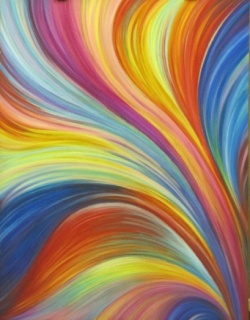
The Seven Rays is a concept related to the Septenary Principle of manifestation of the universe. In The Secret Doctrine, the seven rays refer to the seven Primordial beings that appear on the highest plane of manifestation, in whom are the seeds for everything in the universe. They permeate every plane of the cosmos, including the solar system, the planet, and sentient beings. Later authors developed the subject further, assigning general characteristics to each ray, and applying them to Adepts, religions, human temperament, human activities, colors, crystals, etc. "The ray potentials, when evolved to perfection, will constitute in their harmonious union of differences the full achievement of the Divine plan."[1]
The Primordial Seven
In her book The Secret Doctrine, H. P. Blavatsky quotes a "verse from the Esoteric volumes" as follows:
“Space and Time are one. Space and Time are nameless, for they are the incognizable THAT, which can be sensed only through its seven rays—which are the Seven Creations, the Seven Worlds, the Seven Laws,” etc., etc., etc.[2]
In her writings Mme. Blavatsky identifies the "first seven rays" with the primeval celestial beings variously called Primordial Seven, Dhyāni-Buddhas, Ah-hi or Logoi:[3]
The Ah-hi are the primordial seven rays, or Logoi, emanated from the first Logos, triple, yet one in its essence. . . . The Ah-hi are the highest Dhyanis, the Logoi as just said, those who begin the downward evolution, or emanation.[4]
Each one of these Rays can be identified with one of the seven prismatic colors. However, each one of them contains all the other colors within, which are modified by the dominating color of the particular Ray:
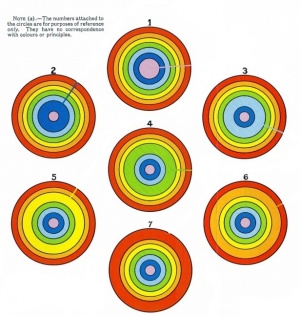
Each of the Primordial Seven, the first Seven Rays forming the Manifested Logos, is again sevenfold. Thus, as the seven colors of the solar spectrum correspond to the seven Rays, or Hierarchies, so each of these latter has again its seven divisions corresponding to the same series of colors.
But in this case one color, viz: that which characterizes the particular Hierarchy as a whole, is predominant and more intense than the others. . . . This color will be the characteristic color of that Hierarchy as a whole.[5]
These Seven Rays are the origin of the seven Principles in Nature[6] and of every being in the universe, human and non-human, celestial and terrestrial:
From this manifested Logos will proceed the Seven Rays, which in the Zohar are called the lower Sephiroth and in Eastern occultism the primordial seven rays. Thence will proceed the innumerable series of Hierarchies.[7]
They [the “luminous sons of manvantaric dawn”] are the primordial seven rays from which will emanate in their turn all the other luminous and non-luminous lives, whether Archangels, Devils, men or apes. Some have been and some will only now become human beings. It is only after the differentiation of the seven rays and after the seven forces of nature have taken them in hand and worked upon them, that they become cornerstones, or rejected pieces of clay. Everything, therefore, is in these seven rays. . .[8]
That group of celestial Beings who are universally called the seven Primeval Gods or Angels—our Dhyâni-Chohans—the “Seven Primeval Rays” or Powers, adopted later on by the Christian Religion as the “Seven Angels of the Presence” [are] Arupa, formless, at the upper rung of the ladder of Being, materializing more and more as they descend in the scale of objectivity and form, ending in the grossest and most imperfect of the Hierarchy, man—it is the former purely spiritual group that is pointed out to us, in our Occult teaching, as the nursery and fountainhead of human beings.[9]
Rays and Principles
These seven hierarchies are the "nursery and fountainhead of human beings" because they provide him with his seven Principles:
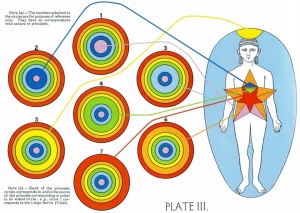
The seven prismatic colors are direct emanations from the Seven Hierarchies of Being, each of which has a direct bearing upon and relation to one of the human principles, since each of these Hierarchies is, in fact, the creator and source of the corresponding human principle.[10]
Each Hierarchy furnishes the Aura of one of the seven principles in man with its specific color. Further, as each of these Hierarchies is the Ruler of one of the Sacred Planets, it will easily be understood how Astrology came into existence.[11]
It is for this reason that human beings can be "divided into seven distinct groups",[12] belonging to one of these seven rays:
The “triads” [or Monads] born under the same Parent-planet, or rather the radiations of one and the same Planetary Spirit (Dhyani Buddha) are, in all their after lives and rebirths, sisters, or “twin-souls,” on this Earth. This was known to every high Initiate in every age and in every country: “I and my Father are one,” said Jesus (John 10:30). When He is made to say, elsewhere (20:17): “I ascend to my Father and your Father,” it meant that which has just been stated. It was simply to show that the group of his disciples and followers attracted to Him belonged to the same Dhyani Buddha, “Star,” or “Father,” again of the same planetary realm and division as He did.[13]
According to T. Subba Row
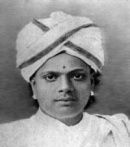
T. Subba Row regarded the seven rays as the seven primordial forms of energy/forces that come from the Logos and stated that everything in the universe is formed by a combination of these rays:
The seven rays we have spoken of represent the outflowing energy from the seven centres of force in the Logos; they represent seven forces, so to speak, which must enter into everything in the universe. No object can exist without the presence of each of these seven forces.[14]
These Seven Rays have their own distinctive consciousness, although the consciousness of all the other rays are present in each one:
Each of the seven classes of Logoi has its own peculiar consciousness, and knows that this is so; that is to say, each Logos recognises its own light; but each Logos also participates in the life of all the other classes of Logoi; that is to say, the peculiar quality of their life is represented in it also; so that an individuality, in merging in a particular Logos, is not cut off from the consciousness of the other Logoi, but shares in, and experiences, their consciousness also.[15]
The last sentence refers to the fact that at the end of its evolution a particular Monad will merge into the Ray to which it belongs, although it will be able to experience the consciousness of the other Rays as well. According to Subba Row, the connection between a Monad and a particular Ray is not there originally, but happens during the course of the evolution of each human being:
When the seven rays we have spoken of proceed from the Logos, they are separate, and subsequently co-mingle in the formation of all beings. When an individual begins his course of evolution, these rays are equally balanced in him, none preponderating more than another. In the course of time the man's actions, his karma, cause him to come particularly under the influence of one or another of the rays. Up this ray he must make his further progress, till he has succeeded in merging his life in the life of the Logos - the grand fountain-head of light and power.[16]
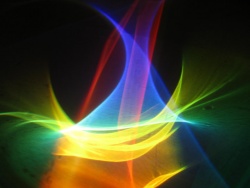
T. Subba Row did not think it possible to guess the Ray the Monad of a person belongs to by merely looking at characteristics of the personality:
A man's past Karma determines which of the seven, practically speaking, five rays, of occult wisdom he shall take his place in; but it is impossible to say that the fact of belonging to one of these rays indicates the presence in a man of any particular moral or mental quality, such as patience, honesty, or courage, on the one hand, or the poetic or artistic faculty, on the other.[17]
The phrase "practically speaking, five rays" in the previous quote is based on his view that the first two Rays are special. They are of a universal nature and their influence can apply to all people, while the other five are more "individual". For this reason also, all world religions, although belonging to different rays, were developed under the influence of the two first Rays:
Though each man belongs to a particular Ray of his own, it is only the first two Rays that have ever given rise to universal religions. In the case of the other five Rays a man is merely concerned with his own particular Ray.[18]
That is the reason why Buddhism and the first Ray have given rise to universal creeds. The other five Rays, though of course important, have not given rise to universal religions, because not applicable to all people.[19]
Finally, this feature is also reflected in the Brotherhood of Adepts:
In the adept hierarchy, there are always seven classes of adepts, corresponding to the seven rays of the Logos. Two of these classes of adepts are so mysterious, and their representatives on earth so rare, that they are seldom spoken of. Perhaps one or two adepts of these two mysterious orders appear every two or three thousand years. It is probable that Buddha and Sankaracarya come under this category. But of the other five classes of adepts, representatives are always to be found on earth. All five classes are represented in the Himalayan school. At present, it is unlikely that all five classes are represented in Southern India: though all the adepts of this and every other school must belong to one of these five classes.[20]
According to C. W. Leadbeater
C. W. Leadbeater stated that the seven Planetary Logoi are the source of the seven rays:
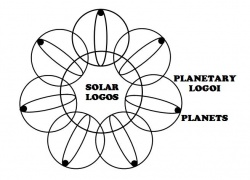
The Mystical Seven, the great Planetary Logoi, who are life-centres in the very Logos Himself . . . are the true Heads of our Rays--the Heads for the whole solar system, not for our world only. . . .
They are the Seven Sublime Lords of The Secret Doctrine, the Primordial Seven, the Creative Powers, the Incorporeal Intelligences, the Dhyan Chohans, the Angels of the Presence . . . because They stand ever in the very presence of the Logos Himself, representing there the Rays of which They are the Heads--representing us therefore, since in every one of us is part of the Divine Life of every one of Them.[21]
He explained that the Monads come forth from the undifferentiated source of the first Logos through one of seven Planetary Logoi, which act as "channels" of the divine life. In so doing, the Monads assume their different "colors":
When, then, that primordial matter or spirit, which in the future was to become ourselves, first emerged from undifferentiated infinity, it issued through seven channels, as water might flow from a cistern through seven pipes, each of which, containing its peculiar colouring matter, would so tinge the water that passed through it that it would for ever after be distinguishable from the water of the other pipes.[22]
However, although the Monads have their own primordial color, they still have elements of all the other Rays in them:
Out through one or other of that mighty Seven every one of us must have come, some through one, some through another. . . . For though each of us belongs fundamentally to one Ray --the channel through which he, as a Monad, flowed forth from the Eternal into Time-- yet has he within himself something of all the Rays; there is in him no ounce of force, no grain of matter, which is not actually part of one or other of these wondrous Beings; he is literally compacted of Their very substance--not of one, but of all, though always one predominates. Therefore, no slightest movement of any of these great Star Angels can occur without affecting to some extent every one of us, because we are bone of Their bone, flesh of Their flesh, Spirit of Their Spirit; and this great fact is the real basis of the often misunderstood science of Astrology.[23]
Even though the Monad in each individual belongs to one of the Rays, determining a person's ray is not easy:
From all that I have said above it follows that these seven types are visible among men, and that every one of us must belong to one or other of the Rays. . . It is, however, by no means an easy matter to discover to what Ray an ordinary man belongs, for he has become very much involved in matter and has generated a great variety of karma, some portion of which may be of a kind that dominates and obscures his essential type, even perhaps through the whole of an incarnation; but the man who is approaching the Path ought to be showing in himself a definite driving impulse or leading power, which has the character of the Ray to which he belongs, and tends to lead him into the kind of work or service which distinguishes that Ray; and it will also bring him to the feet of one of the Masters upon it, so that he becomes enrolled, as it were, in the College of which the Chohan of the Ray may be regarded as the Principal.[24]
The Rays and the Adepts

Leadbeater explained that the Adepts belong to different Rays, which are more clearly distinguished:
In the members of the Adept Brotherhood the distinctions of Rays are much more clearly marked than in others, and are visible in the aura; the Ray to which an Adept belongs decidedly affects not only His appearance, but also the work that He has to do. . . . It must be understood that we can here mention but the merest outline of the qualities that are grouped under each of the Rays, and but a fragment of the work that the Adepts on those Rays are doing; and care must be taken also to realize that full possession of the qualities of one Ray in no case implies a lack of those of the other Rays. If we speak of one of the Adepts as pre-eminent in strength, for example, it is also true that He has achieved nothing less than human perfection in devotion and love and every other quality as well.[25]
Below is a list of Adepts heads of Rays (Chohans) and a brief reference to their work according to C. W. Leadbeater:[26]
- First Ray: Master Morya. "He stands with all the unshakable and serene strength of His Ray, playing a great part in that work of guiding men and forming nations."
- Second Ray: Master Kuthumi. "Ray of Wisdom, which gives great Teachers to the world."
- Third Ray: The Venetian: In this Ray "there appears very strongly the characteristic of adaptability [with] great tact, and a rare faculty for doing the right thing at the right moment. Astrology is connected with this Ray."
- Fourth Ray: Master Serapis. "Harmony and beauty, and people who belong to His type are always unhappy until they can introduce harmony into their environment . . . Art counts for much on this Ray."
- Fifth Ray: Master Hilarion. "His influence is upon most of the great scientists of the world, and people well advanced along His Ray are notable for their ability to make accurate observations, and be absolutely dependable where scientific investigation is concerned."
- Sixth Ray: Master Jesus. "This is the Ray of the devotional saints and mystics of every religion."
- Seventh Ray: Comte de St. Germain. "He works to a large extent through ceremonial magic, and employs the services of great Angels."
He also related the three aspects of the Logos with the different Rays, as they express through the Heads of the Brotherhood of Adepts:[27]
As the Logos is a Trinity, so the Occult Government of the world is in three great departments, ruled by three mighty Officials, who are not merely reflections of the Three Aspects of the Logos, but are in a very real way actual manifestations of Them. They are the Lord of the World, the Lord Buddha and the Mahachohan, who have reached grades of Initiation which give them waking consciousness on the planes of nature beyond the field of evolution of humanity, where dwells the manifested Logos. The Lord of the World is one with the First Aspect on the highest of our seven planes, and wields the divine Will on earth; the Buddha is united with the Second Aspect which dwells on the Anupadaka plane, and sends the divine Wisdom down to mankind; the Mahachohan is utterly one with the Third Aspect, which resides in the Nirvanic plane and exercises the divine Activity--representing the Holy Ghost. He is verily the Arm of the Lord stretched out into the world to do His work. The following table will make this clear:
Logos Divine Powers Planes of Nature Triangle of Agents Ray 1st Aspect Will Adi or Originating The Lord of the World 1 2nd Aspect Wisdom Anupadaka or Monadic The Lord Buddha 2 3rd Aspect Activity Atmic or Spiritual The Mahachohan 3-7
According to Ernest Wood
Ernest Wood related each of the Rays with seven universal principles: the three aspects of consciousness (ichchhā, jñāna and kriyā) and matter (sattva, rajas and tamas), and the field of illusion in which consciousness and matter relate as if they were separate (māyā). He then makes these principles correcpond to ideals and fields of activity that people of the different Rays feel attracted to. Below is a table summarizing his approach:
| Ray | Principle | Qualities of God and Ideals of Men | Expressions in Human Affairs |
|---|---|---|---|
| 1st | Ichchhā (will) | Freedom | Government |
| 2nd | Jñāna (knowledge or wisdom) | Unity | Philanthropy |
| 3rd | Kriyā (action) | Comprehension | Philosophy |
| 4th | Māyā (consciousness/matter relationship) | Harmony | Interpretation (imagination) |
| 5th | Sattwa (law, balance) | Truth | Science |
| 6th | Rajas (energy) | Goodness | Religion |
| 7th | Tamas (inertia) | Beauty | Art |
According to Geoffrey Hodson
Geoffrey Hodson applied the Rays mainly to the different human temperaments, as follows:
| Ray | Human Characteristic |
|---|---|
| 1st | Power, will, courage, leadership, self-reliance. |
| 2nd | Universal love, wisdom, insight, intuition, philanthropy, sense of oneness, spiritual sympathy, cooperativeness. |
| 3rd | Creative ideation, comprehension, understanding, penetrative and interpretive mental power, adaptability, tact, dignity, impartiality. |
| 4th | Stability, harmony, balance, beauty, rhythm. |
| 5th | Analytical and logical mentality, accuracy, patience. |
| 6th | One-pointedness, ardour, fiery enthusiasm, devotion, sacrificial love, loyalty. |
| 7th | Grace, precision, ordered beauty and activity, chivalry, skill, dignity, noble bearing, careful attention to detail, order & method, military method, splendour. |
See also
Online resources
Articles
- "Seven Rays" at Theosopedia
- "The Masters and the Path, Chapters XII and XIII" by C. W. Leadbeater
- "First Rays in Buddhism" by T. Subba Row
- "Occultism of Southern India" by T. Subba Row
- "Our Seven Divine Parents: A Study in Monads, Rays, and Planets" at Blavatsky Theosophy Group
Books
- The Seven Human Temperaments by Geoffrey Hodson
- The Seven Rays by Ernest Wood
- The Seven Rays of Development by Arthur W. Ward. 2nd edition. London: Theosophical Publishing House, 1919.
Audios
- The Seven Rays by Geoffrey Hodson
Videos
Notes
- ↑ James S. Perkins, Visual Meditations on the Universe (Wheaton, Illinois: Theosophical Publishing House, 1984), 23.
- ↑ Helena Petrovna Blavatsky, The Secret Doctrine vol. II, (Wheaton, IL: Theosophical Publishing House, 1993), 612.
- ↑ Helena Petrovna Blavatsky, Collected Writings vol. X (Wheaton, IL: Theosophical Publishing House, 1988), 323.
- ↑ Helena Petrovna Blavatsky, Collected Writings vol. X (Wheaton, IL: Theosophical Publishing House, 1988), 317-318.
- ↑ Helena Petrovna Blavatsky, Collected Writings vol. XII (Wheaton, IL: Theosophical Publishing House, 1980), 567.
- ↑ Helena Petrovna Blavatsky, The Secret Doctrine vol. I, (Wheaton, IL: Theosophical Publishing House, 1993), 262.
- ↑ Helena Petrovna Blavatsky, Collected Writings vol. X (Wheaton, IL: Theosophical Publishing House, 1988), 352.
- ↑ Helena Petrovna Blavatsky, Collected Writings vol. X (Wheaton, IL: Theosophical Publishing House, 1988), 347-348.
- ↑ Helena Petrovna Blavatsky, Collected Writings vol. XIV (Wheaton, IL: Theosophical Publishing House, 1995), 379.
- ↑ Helena Petrovna Blavatsky, Collected Writings vol. XII (Wheaton, IL: Theosophical Publishing House, 1980), 549.
- ↑ Helena Petrovna Blavatsky, Collected Writings vol. XII (Wheaton, IL: Theosophical Publishing House, 1980), 567.
- ↑ Helena Petrovna Blavatsky, The Secret Doctrine vol. I, (Wheaton, IL: Theosophical Publishing House, 1993), 573.
- ↑ Helena Petrovna Blavatsky, The Secret Doctrine vol. I, (Wheaton, IL: Theosophical Publishing House, 1993), 573.
- ↑ Tallapragada Subba Row, Esoteric Writings, (Adyar, Madras: The Theosophical Publishing House, 1980), 108.
- ↑ Tallapragada Subba Row, Esoteric Writings, (Adyar, Madras: The Theosophical Publishing House, 1980), 111-112.
- ↑ Tallapragada Subba Row, Esoteric Writings, (Adyar, Madras: The Theosophical Publishing House, 1980), 111.
- ↑ Tallapragada Subba Row, Esoteric Writings, (Adyar, Madras: The Theosophical Publishing House, 1980), 108.
- ↑ Tallapragada Subba Row, Esoteric Writings, (Adyar, Madras: The Theosophical Publishing House, 1980), 527.
- ↑ Tallapragada Subba Row, Esoteric Writings, (Adyar, Madras: The Theosophical Publishing House, 1980), 529.
- ↑ Tallapragada Subba Row, Esoteric Writings, (Adyar, Madras: The Theosophical Publishing House, 1980), 106.
- ↑ Charles Webster Leadbeater, The Masters and the Path, (Adyar, Madras: The Theosophical Publishing House, 1992), 231.
- ↑ Charles Webster Leadbeater, The Masters and the Path, (Adyar, Madras: The Theosophical Publishing House, 1992), 233.
- ↑ Charles Webster Leadbeater, The Masters and the Path, (Adyar, Madras: The Theosophical Publishing House, 1992), 232.
- ↑ Charles Webster Leadbeater, The Masters and the Path, (Adyar, Madras: The Theosophical Publishing House, 1992), 235.
- ↑ Charles Webster Leadbeater, The Masters and the Path, (Adyar, Madras: The Theosophical Publishing House, 1992), 236-237.
- ↑ Charles Webster Leadbeater, The Masters and the Path, (Adyar, Madras: The Theosophical Publishing House, 1992), 237-240.
- ↑ Charles Webster Leadbeater, The Masters and the Path, (Adyar, Madras: The Theosophical Publishing House, 1992), 254-255.